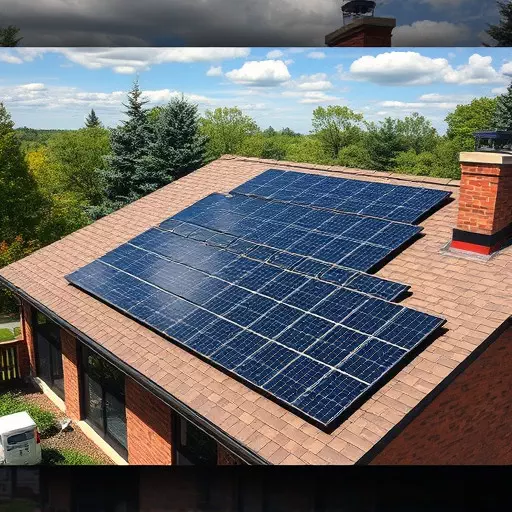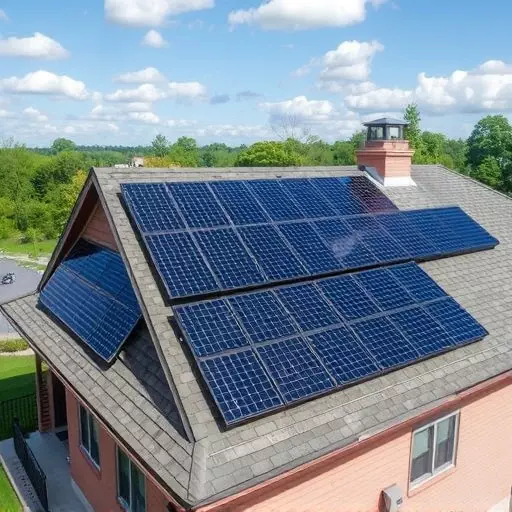Solar roofing systems in Appleton, Wisconsin offer a sustainable and cost-effective solution for homeowners looking to reduce their carbon footprint and energy bills. These systems utilize photovoltaic (PV) panels integrated into traditional roof tiles or shingles to generate clean, renewable electricity from sunlight. With minimal maintenance, a long lifespan, and government incentives, solar roofs represent a smart investment that contributes to both environmental preservation and financial savings.
Discover the transformative power of solar roof tiles and their growing popularity in Appleton, Wisconsin. This comprehensive guide explores the solar roofing systems that seamlessly integrate clean energy technology into your home’s exterior. From understanding photovoltaic panels to unlocking the benefits for homeowners, we demystify this sustainable choice. Learn about the innovative solar roof tiles technology, their installation process, and how they’re shaping the future of solar roofing systems in Appleton and beyond.
- Understanding Solar Roofing Systems: A Basic Guide
- The Benefits of Installing Photovoltaic Panels on Your Roof
- How Solar Roof Tiles Work: A Step-by-Step Explanation
- Exploring the Advantages for Homeowners in Appleton, Wisconsin
- Choosing the Right Solar Roofing System for Your Property
- Installation Process: What to Expect During the Transition
- Future of Solar Energy: Trends Shaping the Industry
Understanding Solar Roofing Systems: A Basic Guide
Solar roofing systems are a cutting-edge solution for homeowners looking to reduce their carbon footprint and energy costs in Appleton, Wisconsin, and beyond. These innovative systems integrate photovoltaic (PV) panels seamlessly into traditional roof tiles or shingles, allowing your home to generate clean, renewable electricity while enhancing its aesthetic appeal. The process starts with the installation of PV panels, which are composed of semi-conductive materials that convert sunlight into electricity.
Unlike conventional roofing, solar roofing systems require minimal maintenance and can last for decades. When sunlight hits the panels, it triggers a chemical reaction that produces direct current (DC) power. This power is then converted to alternating current (AC) through an inverter, which your home uses to power appliances and lighting. Any excess energy generated can be stored in batteries or fed back into the grid, providing potential cost savings on your electricity bills.
The Benefits of Installing Photovoltaic Panels on Your Roof
Installing photovoltaic (PV) panels on your roof is a smart move for many homeowners in Appleton, Wisconsin, and beyond. It offers a range of benefits that extend far beyond simply generating clean energy. First and foremost, solar roofing systems can significantly reduce electricity bills. By harnessing the power of the sun, you can offset a substantial portion of your energy consumption, leading to long-term savings on your utility expenses.
Moreover, PV panels contribute to a greener and more sustainable future. As Appleton continues to promote eco-friendly initiatives, adopting solar roofing systems aligns with these goals. They produce zero emissions, reducing your carbon footprint and helping to mitigate the environmental impact of energy generation. With government incentives and tax credits also available for solar installations, there are financial benefits to embracing this renewable energy technology.
How Solar Roof Tiles Work: A Step-by-Step Explanation
Solar roof tiles are an innovative and efficient way to harness the power of the sun for your home’s energy needs. These tiles, designed to look like traditional roofing materials, incorporate photovoltaic (PV) panels that convert sunlight into electricity. The process begins with the tiles absorbing sunlight, which excites electrons in the PV material, generating a flow of direct current (DC) electricity. This DC power is then channeled through wires integrated into the tile system and sent to an inverter, where it’s transformed into alternating current (AC) electricity – the standard form used in most homes.
The AC electricity produced can be used immediately to power your home or stored in batteries for later use. An added benefit of solar roofing systems, like those offered by solar roofing systems Appleton Wisconsin-based companies, is their reduced environmental impact compared to traditional energy sources. By adopting solar roofing systems, homeowners contribute to a cleaner, more sustainable future while potentially reducing their carbon footprint and long-term energy costs.
Exploring the Advantages for Homeowners in Appleton, Wisconsin
Appleton, Wisconsin homeowners are increasingly exploring the advantages of transitioning to solar roofing systems. This shift is driven by both environmental concerns and practical benefits. Solar roofing systems in Appleton offer a path to energy independence, allowing property owners to harness the power of the sun and generate clean electricity for their homes. By installing photovoltaic (PV) panels on their roofs, residents can significantly reduce their carbon footprint while enjoying long-term savings on energy bills.
The appeal of solar roofing systems extends beyond financial and environmental advantages. In Appleton’s unpredictable weather patterns, a well-designed solar system can be resilient and reliable, providing uninterrupted power supply even during cloudy or snowy days. Moreover, with the growing number of incentives and rebates offered by local and state governments, the initial investment in solar roofing systems becomes more accessible, making it an attractive option for homeowners looking to modernize their properties and contribute to a sustainable future.
Choosing the Right Solar Roofing System for Your Property
When considering a solar roofing system for your Appleton, Wisconsin property, it’s crucial to assess your energy needs and available space. Solar roofing systems, like those equipped with photovoltaic (PV) panels, offer an efficient way to harness clean energy from the sun. However, not all systems are created equal. You’ll want to choose one that aligns with your roof’s structure, orientation, and shading potential.
Researching local regulations and working with certified professionals is key. The right solar roofing system should be designed to withstand Wisconsin’s climate, including potential snow and wind loads. Additionally, consider energy storage options for optimal efficiency, especially if you aim to reduce your carbon footprint significantly. Remember, a well-chosen solar roofing system can provide long-term savings on your energy bills while contributing to a greener environment.
Installation Process: What to Expect During the Transition
Switching to a solar roofing system in Appleton, Wisconsin, is an exciting step towards a greener future. During the installation process, homeowners can expect a few key steps that mark this transition. First, a thorough assessment of your roof is conducted to ensure it’s suitable for photovoltaic (PV) panels. This includes checking its structural integrity and orientation for optimal sunlight exposure. Once approved, the old roofing materials are carefully removed, preparing the roof for the new solar tiles or panels.
The next phase involves installing the solar roofing system. In Appleton, professional installers will either lay down solar tiles that mimic traditional roofing aesthetics or mount PV panels. Wiring is then connected to these panels, allowing them to capture sunlight and convert it into electricity. Throughout this process, homeowners are often provided with a clear timeline and regular updates to ensure they know what to expect at each stage, making the transition as smooth as possible.
Future of Solar Energy: Trends Shaping the Industry
The future of solar energy is bright and dynamic, with trends shaping the industry across the globe. One notable trend is the integration of solar roofing systems, which are becoming increasingly popular in cities like Appleton, Wisconsin. Solar roofing systems offer a seamless and aesthetically pleasing way to generate clean energy for homes and businesses. By incorporating photovoltaic (PV) panels into traditional roofing materials, homeowners can reduce their carbon footprint while also lowering utility bills.
The evolution of PV technology is driving this shift. Advancements in efficiency and durability make solar panels more accessible and cost-effective than ever before. As a result, many homeowners are opting for solar roofing systems as a long-term investment. Additionally, government incentives and tax credits continue to support the adoption of renewable energy sources, making it an attractive option for those looking to reduce their environmental impact and save money on energy costs.


